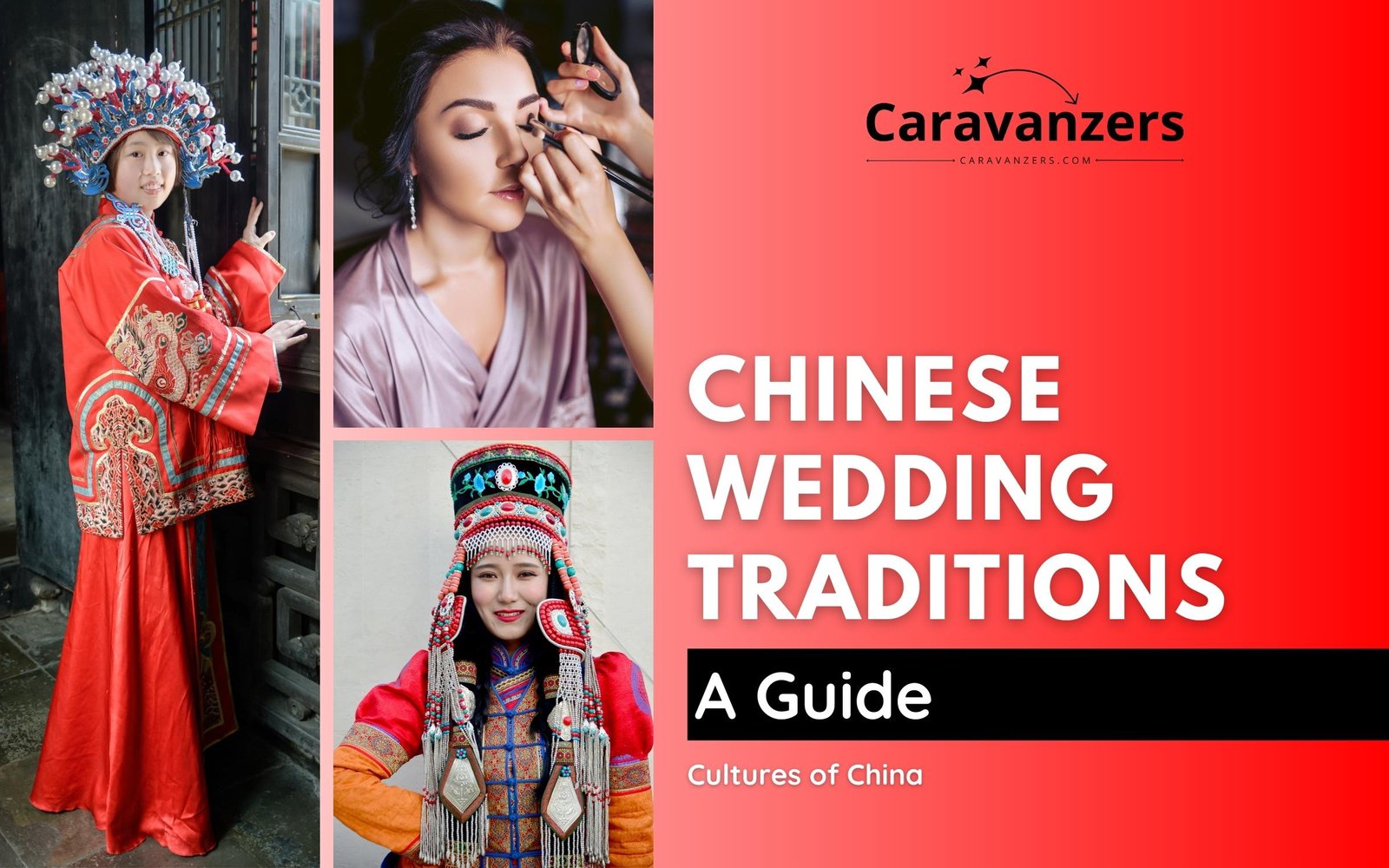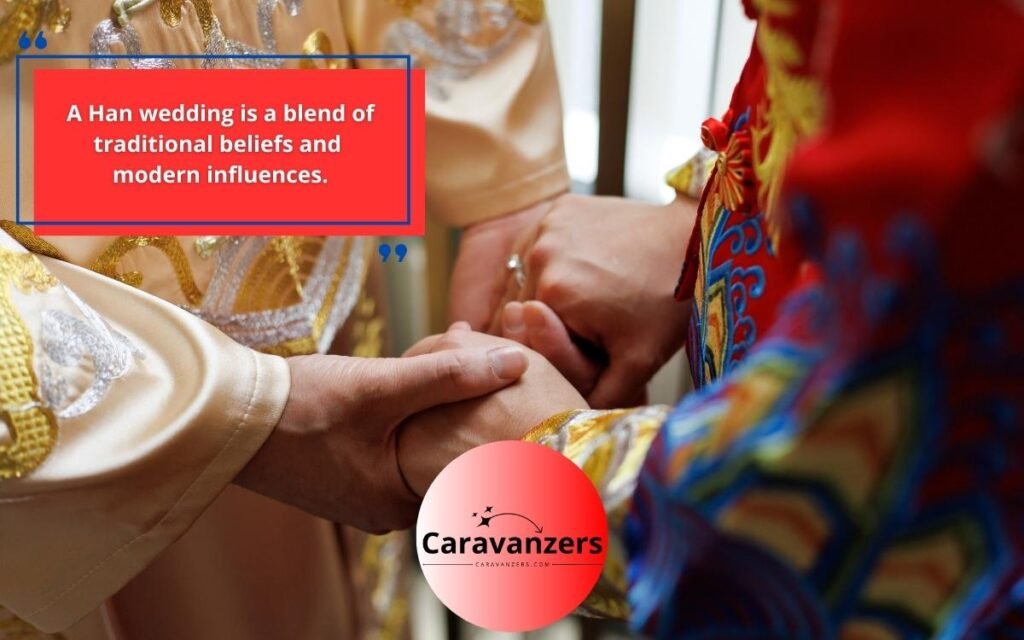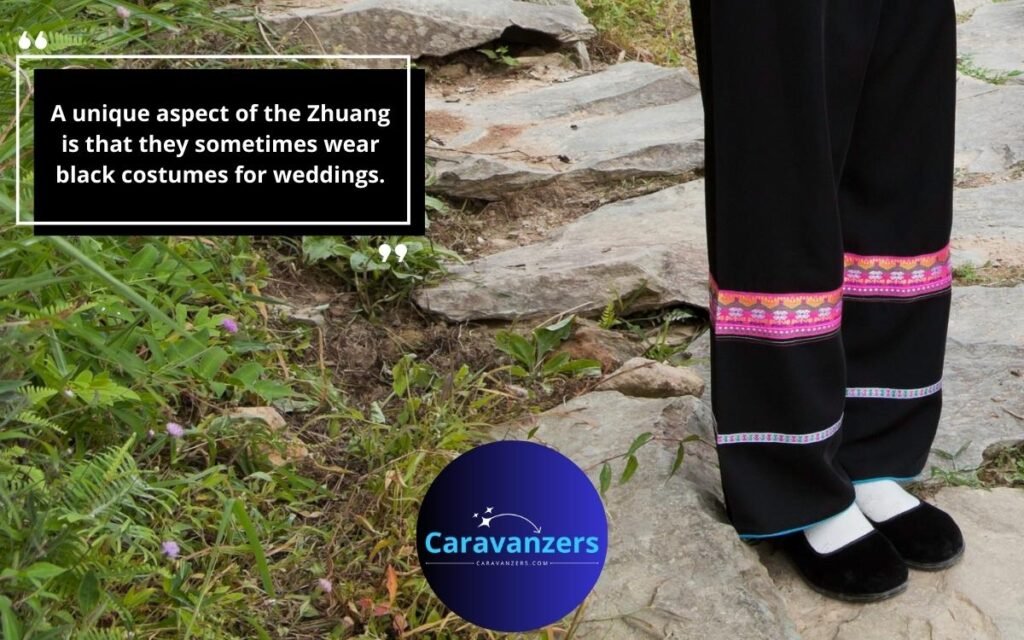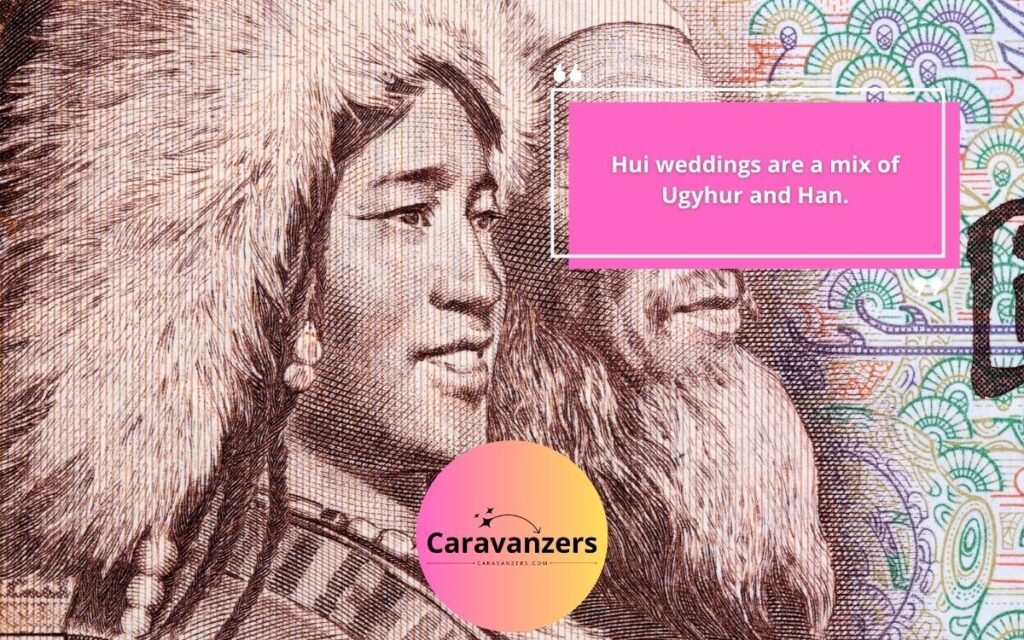
Chinese wedding traditions are incredibly diverse, reflecting the rich cultural heritage of the country.
Growing up in a Han family, I didn’t know that there were different ethnic groups in China, such as the Zhuang, Uyghur, Hui, Tibetan, and Mongolian.
I did not know that they all have distinct wedding traditions.
The Han wedding traditions, which are the most common in China, blend traditional and modern influences.
On the other hand, of course, there are many examples of weddings that highlight the incredible diversity of Chinese cultures.
Unfortunately, Han culture dominates China due to the overwhelming majority of this ethnic group in the country.
This dominance is reflected in popular TV shows and media, where Han individuals are often prominently featured.
As the largest ethnic group in China, the cultural influence of the Han is widespread, shaping societal norms, language, traditions, and entertainment.
So, as the years go by, more Chinese people, especially Han, get to learn about the diversity of our country.
I’m happy to say that more Chinese people are learning about minorities these days, and we have documentaries on major tv networks featuring their cultures.
What I learned myself is that there are so many types of Chinese wedding traditions and that they are all great.
Each Chinese wedding tradition showcases distinct customs, beliefs, and traditions influenced by the ethnic groups’ cultural backgrounds and historical practices.
In this article, I will present some of these traditions to you.
Chinese Diversity
The Chinese government recognizes a total of 56 distinct ethnic groups.
The largest and most dominant among them are the Han.
I belong to this group. I would say that we are over 90% of the Chinese population.
Among the minority ethnic groups, the Zhuang people stand out as the largest.
They primarily reside in the Guangxi Zhuang Autonomous Region.
The Hui people form the largest Muslim ethnic group in China.
They can be found throughout the country and have assimilated with the Han Chinese culture while maintaining their Islamic faith and traditions.
Meanwhile, other smaller ethnic groups include the Uyghurs, Tibetan, Yi, and Miao, as well as the Mongols, and they are all over the country.
In the northeastern part of China, you will find the Korean ethnic group.
Lastly, the Manchus historically formed the ruling class of the Qing Dynasty, and they are mostly in the northeastern provinces.
These ethnic groups represent just a glimpse of the incredible diversity found within China.
Each group has its own distinct language, customs, traditional clothing, festivals, and cuisine, which all contribute to the multicultural fabric of Chinese society.
Han Chinese Wedding Traditions

So, the Han (Hànzú or 汉族) are the majority, with about 90% of the population.
A Han wedding is a blend of traditional beliefs and modern influences.
Generally speaking, a Han wedding includes aspects such as matchmaking, wedding planning, and inviting guests.
Likewise, there are dowry gifts, a bedding ceremony, and a lot of yummy food.
Similarly, there are wedding photos, preparations, sibling feasts, and the dress.
Of course, there is also bride fetching, ceremony, reception with music, collection of gifts, special timings, and so much more.
Han weddings are deeply rooted in Taoism, Confucianism, Buddhism, and folk religion.
Matchmaking plays a significant role in finding suitable partners, and there are traditional methods like marriage markets as well as modern approaches such as online platforms.
Wedding planning revolves around selecting auspicious dates, and the groom’s family traditionally bears financial responsibilities, including the bride price.
Dowry gifts are exchanged between the families, including cakes, alcohol, and symbolic items.
The bedding ceremony is a unique aspect of Han weddings, where an older woman blesses the marriage bed with red bedsheets and lamps for luck and a happy family.
The night before the wedding, rituals like lighting dragon and phoenix candles and hair combing customs take place.
So, the wedding day starts with the sibling feast, followed by the bride’s last meal as an unmarried woman.
The traditional Han wedding dress is typically a red dress with a phoenix crown, symbolizing the bride.
The groom and his groomsmen then fetch the bride from her home, overcoming door games set up by the bridesmaid.
Finally, the wedding ceremony takes place, followed by a reception and the collection of gifts.
>> To read my previous article on Chinese weddings that was heavily of Han, visit that article.
Zhuang Wedding Traditions

The Zhuang people (Zhuàngzú or 壮族) are a Tai-speaking ethnic group, and they follow the Mo religion.
At just 20 million, they are the second largest ethnic group in China.
The Zhuang are much larger than the Greeks, and yet not many people even know the name of this Chinese ethnic group outside of academic circles.
So, the Zhuang mostly live in the Guangxi Zhuang Autonomous Region in Southern China (as you can see, it’s named after their ethnic group).
They are one of the officially recognized 56 ethnic groups in China.
Zhuang wedding customs are really interesting, and these traditions include distinct rituals.
For example, one of the interesting aspects of the Zhuang wedding traditions is that it includes one where a boy is his maternal cousin.
Unlike the Han, they also have a preference for different surnames, which is really cool.
Another unique tradition is that if the bride price is delayed, the bride resides with her family until the birth of their first child!
You could think of this like a layaway wife.
Meanwhile, another of their tradition is that after the wedding ceremony, the bride and groom are separated.
Usually, the bride returns to her parents’ home and visits her husband here and there.
This is very different from the Han, where the wife is kind of “owned” by the in-laws.
Young Zhuang these days use singing parties as a means of courtship, so this trend is becoming more and more “love marriage.”
Another unique aspect of the Zhuang is that they wear black costumes for weddings.
So, yes, the Zhuang have a very cool culture.
Uyghur Wedding Traditions

The Uyghur (Wéiwú’ěrzú or 维吾尔族) is the third largest ethnic group in China, with a population of about 12 million.
As Muslims, the Uyghur follow Islam, and their Turkic background is rooted in the cultures of Central Asia.
Uyghur weddings are very, very different from both the Han and Zhuang.
First of all, there are usually two separate events; one for the actual marriage ceremony and another for a wedding.
A marriage ceremony or “nikah” does not even require the bride!
Only her male official family representation, which could be immediately related or not, and then the officiant or imam and two witnesses.
This part of the Uyghur marriage is not legal in China until registered with the government, but it’s very legal within their culture.
These weddings tend to be grandeur, lively festivities, and distinct practices.
Firstly, they are marked by large-scale celebrations.
Uyghur people believe the more people at a wedding, the more good luck for the coup.
So, often they will have over a thousand attendees.
But the good news is that the wedding is also paid for by the community.
The groom’s family will collect money from their clan for the “mehr” or bride price.
In that case, you could say a wedding is a community party!
Uyghur weddings include dancing, feasting, and continuous merriment.
Like Muslims in many countries, gender segregation is another custom unique to Uyghurs in China.
At weddings, men and women are seated separately in the banquet hall, maintaining a visible division.
Uyghur brides wear white, similar to Turkish styles.
Personally, I find them so much more spirited than Han weddings!
Hui Wedding Traditions

The Hui (Huízú or 回族) are the fourth largest ethnic group, and they number about 11 million.
Now you will understand how China grew, but they are a mix of Han and Muslims (including Persians, Indians, and Turks).
This is an ethnic group that developed during the Great Silk Route culture.
Hui weddings are a mix of Ugyhur and Han.
For the Uyghur, the Hui are more Han, and for the Han, the opposite.
So, yes, they are very interesting!
Like the Ugyhur, their weddings are two separate times, with the ceremony and party being separate.
They also use “ahong” (or Islamic leader) to make marriage legal in their culture.
However, they are like the Han in that they register their marriage.
They also do not like divorces at all, much like the Han.
Also, like the Han, they use matchmaking, the bride wears red, and they have in-laws as prominence also.
Likewise, they have a bride fetching, and in villages, people follow the groom to fetcher. She will cry like the Han.
Very interesting wedding traditions!
Other Chinese Wedding Traditions

Although the Han, Zhuang, Uyghur, and Hui are great examples of Chinese weddings, they are not the only Chinese.
In this section, I would like to combine two other interesting groups; Tibetan and Mongolian.
Tibetan (Zàngzú or 藏族) number about 7 million, and most follow their own version of Buddhism called Tibetan Buddhism.
Weddings in Tibetan culture follow a series of stages rooted in tradition.
A man’s family is interested in a woman, and that family seeks astrological compatibility before proposing with gifts.
If both families agree, an engagement ceremony is held, followed by a wedding on an auspicious day chosen by the groom’s family.
The bride is accompanied to the groom’s house with rituals, and a banquet commemorates the occasion.
Tibetan brides wear white, although other colors are mixed in accessories.
Later, the couple may visit the bride’s parents to complete the wedding ceremony.
Tibetan weddings embrace customs that symbolize the union and celebrate the joining of two families.
Mongolian people (Měnggǔzú or 蒙古族) number 6 million, and they follow the Mongol folk religion as well as Chinese Buddhism.
So, Mongolian weddings blend traditional customs with modern elements.
The groom’s side proposes to the bride’s family, presenting gifts and a “hadag” (silk bride price).
Once accepted, a wedding month is chosen based on consultation with a monk or fortune teller.
Couples often have professional wedding photos taken beforehand, wearing traditional Mongolian clothes.
On the wedding day, the bride receives Mongolian Deel clothing and serves milk tea to the elders.
Rings are exchanged, and in urban areas, there is an official ceremony before the banquet.
Guests offer gifts and enjoy rituals, feasting, dancing, and singing traditional songs.
Mongolian brides wear colorful but mostly red outfits.
How to Get Invited
To witness a wedding while traveling in China, there are a few things you can do.
First of all, consider visiting popular tourist destinations such as Beijing, Shanghai, or Guangzhou.
In big cities, you may find wedding venues that host traditional ceremonies.
For example, there are wedding venues in Beijing such as the Four Seasons Hotel.
This is the type of place where rich Chinese people hold their wedding receptions.
Alternatively, explore local communities and inquire about upcoming weddings at temples, parks, or cultural centers.
Attending a wedding banquet can be a great way to experience Chinese wedding customs and traditions.
Additionally, you may search for wedding planners or agencies that offer cultural experiences for tourists, including attending weddings.
Remember to be respectful, seek permission to attend, and adhere to any cultural protocols during the event.
Final Thoughts
So, did you learn a lot about Chinese wedding traditions now? I really hope so.
As you have seen from photos and videos, Chinese people don’t all look the same.
Han people are recognized worldwide as “Chinese,” but we are only 1 of 56, and I think more and more Chinese people are learning to be comfortable with this fact.
My goal is that after you read this article, maybe you will watch some wedding videos on YouKu (like YouTube but Chinese).
Enjoy it!
Li Xiu Ying is a travel writer and is the author of Beijing Travel. She writes about China for Caravanzers.
Follow us on Pinterest.

One Comment
Comments are closed.